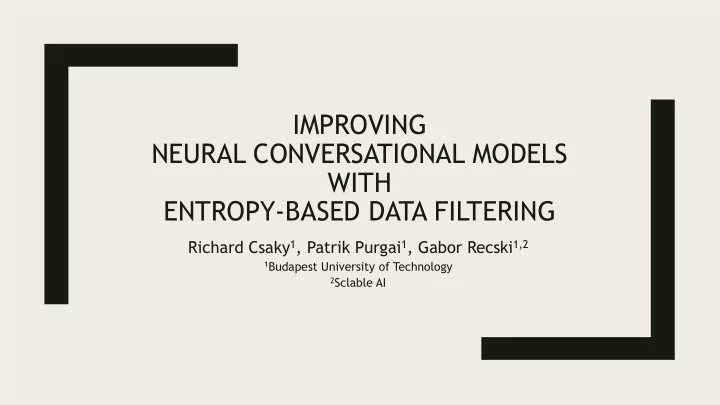

IMPROVING NEURAL CONVERSATIONAL MODELS WITH ENTROPY-BASED DATA FILTERING Richard Csaky 1 , Patrik Purgai 1 , Gabor Recski 1,2 1 Budapest University of Technology 2 Sclable AI
Introduction ■ Takeaways – Better responses by filtering training data – Overfitting = better on automatic metrics Hi, how are you? good What did you do today? I don’t know
Problem formulation Many-to-one One-to-many Previous approaches: Feeding extra information to dialog models [1] Augmenting the model or decoding process [2] Modifying the loss function [3]
Methods (Identity) Filter high-entropy utterances 3 filtering ways: SOURCE, TARGET , BOTH
Methods (Clustering) SENT2VEC [4] and AVG-EMBEDDING [5] Mean Shift clustering algorithm [6]
Data ■ DailyDialog (~90.000 pairs) [7] ■ Remove 5-15% of utterances ■ High entropy utterances: – yes | thank you | why? | ok | what do you mean? | sure
Setup Response length Word / utterance entropy [8] KL-divergence Embedding metrics [9] Coherence [10] Distinct-1, -2 [11] BLEU-1, -2, -3, -4 [12]
Evaluation Metrics
Results (at loss minimum)
Results (after overfitting)
Results (other datasets) Cornell-Movie Dialog Corpus Twitter dataset
Conclusion ■ Better responses by filtering training data ■ Overfitting = better on automatic metrics
Thanks for your attention! ■ github.com/ricsinaruto/NeuralChatbots-DataFiltering – code/utils/filtering_demo.ipynb ■ github.com/ricsinaruto/dialog-eval ■ ricsinaruto.github.io – Paper, Poster, Blog post, Slides References [1] Jiwei Li, Michel Galley, Chris Brockett, Georgios P Spithourakis, Jianfeng Gao, and Bill Dolan. 2016. A persona-based neural conversation model. [2] Yuanlong Shao, Stephan Gouws, Denny Britz, Anna Goldie, Brian Strope, and Ray Kurzweil. 2017. Generating high-quality and informative conversation responses with sequence-to-sequence models. [3] Jiwei Li, Michel Galley, Chris Brockett, Jianfeng Gao, and Bill Dolan. 2016. A diversity-promoting objective function for neural conversation models. [4] Matteo Pagliardini, Prakhar Gupta, and Martin Jaggi. 2018. Unsupervised learning of sentence embeddings using compositional n-gram features. [5] Sanjeev Arora, Yingyu Liang, and Tengyu Ma. 2017. A simple but tough-to-beat baseline for sentence embeddings. [6] Keinosuke Fukunaga and Larry Hostetler. 1975. The estimation of the gradient of a density function, with applications in pattern recognition. [7] Yanran Li, Hui Su, Xiaoyu Shen, Wenjie Li, Ziqiang Cao, and Shuzi Niu. 2017. Dailydialog: A manually labelled multi-turn dialogue dataset. [8] Iulian Vlad Serban, Alessandro Sordoni, Ryan Lowe, Laurent Charlin, Joelle Pineau, Aaron C Courville, and Yoshua Bengio. 2017. A hierarchical latent variable encoder-decoder model for generating dialogues. [9] Chia-Wei Liu, Ryan Lowe, Iulian Serban, Mike Noseworthy, Laurent Charlin, and Joelle Pineau. 2016. How not to evaluate your dialogue system: An empirical study of unsupervised evaluation metrics for dialogue response generation. [10] Xinnuo Xu, Ondrej Dusek, Ioannis Konstas, and Verena Rieser. 2018. Better conversations by modeling, filtering, and optimizing for coherence and diversity. [11] Jiwei Li, Michel Galley, Chris Brockett, Jianfeng Gao, and Bill Dolan. 2016. A diversity-promoting objective function for neural conversation models. [12] Kishore Papineni, Salim Roukos, Todd Ward, and WeiJing Zhu. 2002. Bleu: a method for automatic evaluation of machine translation.
Recommend
More recommend